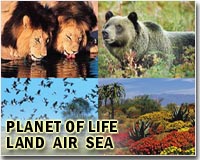 |
Paris (AFP) Feb 23, 2011 For three-quarters of a century, the cane toad has rampaged around northeastern Australia, but scientists hope the toxic terror may at last be stopped in its tracks. A native of Central America, the cane toad (Bufo marinus) was introduced to Australia in 1935 to kill beetles devastating sugar-cane crops, only to become a pest in its own right. But a new investigation says that the toad -- up to 25 centimetres (10 inches) long and two kilos (4.4 pounds) in weight -- has an Achilles' heel. Unlike indigenous amphibians that have adapted to arid conditions, the imported anuran desperately needs access to nearby standing water in order to survive. Placing small fencing around man-made sources such as irrigation ditches and troughs is enough to cause the toad to die of dehydration and stop its advance, says the study. "Basically, step by step, toads use these water points to invade the drier regions of Australia," said University of Melbourne researcher Tim Dempster in an email to AFP. "By stopping toads from using these water points, we are removing their 'stepping stones' in the landscape." Dempster's team experimented with cane toads which were placed near nine artificial water points during the dry season in the Victoria River District of the Northern Territory. Some of the water points were unfenced but others were surrounded by cloth netting 60 centimetres (24 inches) high that also extended along the ground to stop the large toads from burrowing underneath. The netting was secured by wire and metal posts at least two metres (6.5 feet) from the water's edge. All 21 toads placed near fenced-off water points died, and most of them expired within 12 hours. Of the 20 toads with unfettered access to water, all survived except for one, which was killed by a predatory bird. Dempster said that fencing off even a small number of key water points can halt further invasion and save a million square kilometres (386,000 square ft) -- an area roughly twice the size of France -- out of the 2.24 million sq. kms (865 thousand sq. ft) of arid land threatened by the beasts. "The greatest benefit from the technique will be to stop further invasion into several of Australia's drier inland areas which are hotspots of unique native animal biodiversity," Dempster said. The method is feasible for water points that are around 20 metres (70 feet) across, but only key points would need be fenced for the barrier to be effective, he said. B. marinus already extends across 1.2 million square kms (463,000 square miles) of Queensland and the Northern Territory and, advancing at up to 50 kilometres (30 miles) a year, is on course for eventually spreading around three-quarters of Australia's coastline, say some experts. It has driven some native frogs and reptiles to near-extinction, inflicted catastrophic declines in snakes and crocodiles that snack on its flesh and decimated goannas, a native lizard that is also a staple food in aboriginal communities. The invasion has driven Australians to desperation. Residents in toad-infested regions have resorted to gassing the critters, running them over in cars and even whacking them with golf clubs. "Toad busting" is encouraged by state authorities as well. Frog Watch and Stop the Toad Foundation (http://www.stopthetoad.org.au/main/videos.php) also promote fencing as a way to capture cane toads in large numbers. The study appears in Proceedings B, a journal of Britain's Royal Society.
Share This Article With Planet Earth
Related Links Darwin Today At TerraDaily.com
 Japan goes crazy for Chinese pandas
Japan goes crazy for Chinese pandasTokyo (AFP) Feb 21, 2011 Panda fever gripped Japan on Monday as two of the cuddly creatures arrived in the nation from China, with Tokyo zoo eyeing a visitor boom and the government anticipating improved ties with Beijing. Panda flags lined streets near the capital's Ueno Zoo, which is to be the home of the pair of five-year-old giant pandas for the next decade, while television channels ran breathless coverage abou ... read more |
|
| The content herein, unless otherwise known to be public domain, are Copyright 1995-2010 - SpaceDaily. AFP and UPI Wire Stories are copyright Agence France-Presse and United Press International. ESA Portal Reports are copyright European Space Agency. All NASA sourced material is public domain. Additional copyrights may apply in whole or part to other bona fide parties. Advertising does not imply endorsement,agreement or approval of any opinions, statements or information provided by SpaceDaily on any Web page published or hosted by SpaceDaily. Privacy Statement |